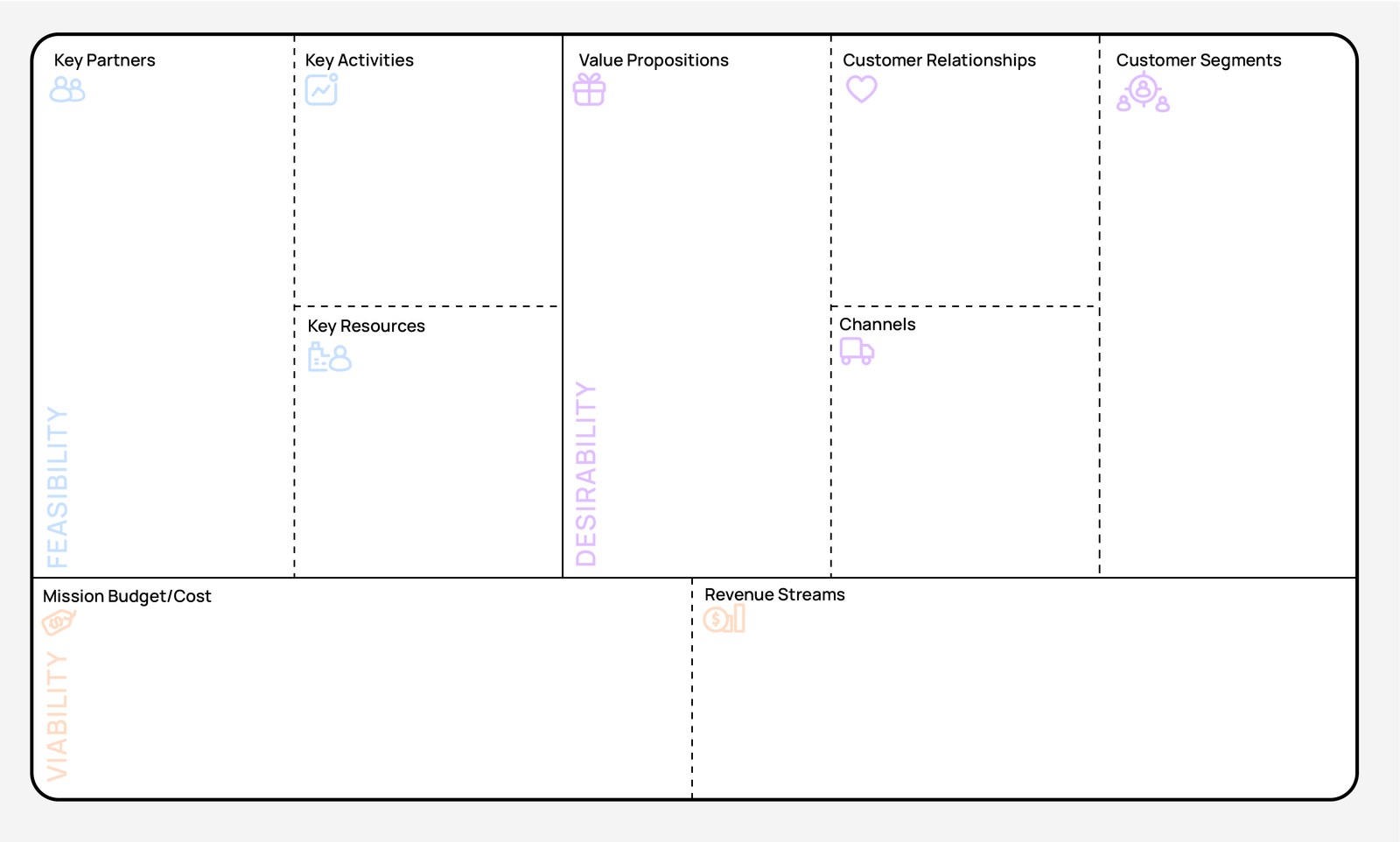Business Model Canvas
The Business Model Canvas (BMC) is a tool used to develop new business models or document and refine existing ones.
The BMC has nine key sections dedicated to various aspects of a business model. These sections are:
- Customer Segments: Different customer groups that an organisation targets with offerings
- Value Propositions: Things that make customers want to buy the offering from an organisation
- Channels: Ways an organisation reaches and sells to customers, like online or through retail stores
- Customer Relationships: Ways an organisation makes its customers happy and keeps them coming back
- Revenue Streams: Ways money is made by the organisation
- Key Resources: Important things needed to create and deliver an offering, like people, equipment, or technology
- Key Activities: Important tasks and processes to run the organisation
- Key Partnerships: External parties that help in achieving the organisations goals
- Cost Structure: Ways the organisation spends money on to deliver the offering
The results
- A well-defined business model and value proposition that are clearly articulated and understood.
- Alignment among stakeholders

When to use it
Starting a new venture: When outlining and validating the fundamental structure of a new business idea
Pivoting an existing venture: When reassessing and adjusting the business model to adapt to market changes
Strengths
Visual clarity
Ease of use
Holistic view
Weaknesses
Can over-simplify the business model
Not suitable for complex or multi-sided business models
How to use it?
What do I need to start?
Having the following inputs can be helpful when using the BMC:
- Market research: Insights into industry trends, customer needs, and competitors
- Customer feedback: Insights from current or potential customers about their preferences and pain points
How to use it?
Who to involve?
Creating a BMC is best done with a team. Consider involving:
- People who have a clear vision and understanding of the organisation’s goals
- Individuals with insights into customer needs and behaviours
Step by step
1
Set the context
Define the scope and objectives of completing the BMC. Ask questions like:
- What is the primary goal of this exercise?
- What specific outcomes are we aiming to achieve?
- How will this canvas help us?
2
Complete each section on the canvas
Value Proposition
Define what unique value the product or service offers to customers. Ask questions like:
- What specific problem does our offering solve?
- What are the unique benefits or features we offer?
- How is our value proposition different from competitors?
Customer Segments
Identify and describe the different customer groups that the organisation aims to serve. Ask questions like:
- Who are our primary customer groups?
- What are their specific needs and characteristics?
- How do these segments differ from one another?
Channels
List the ways the organisation will deliver the value proposition to target customer segments (e.g. online and retail stores). Ask questions like:
- Which channels do our customers prefer to engage with us through?
- How can we effectively reach each customer segment?
- How can we optimise our channels for better delivery?
Customer Relationships
Describe the type of relationship the organisation will establish with each customer segment. Ask questions like:
- What type of interactions do customers expect?
- How will we build and maintain customer loyalty?
- What methods will we use to gather and act on customer feedback?
Revenue Streams
Identify the sources of revenue for each customer segment. Ask questions like:
- How do we generate income from each customer segment?
- What pricing strategy will we use?
- Are there alternative revenue sources we could explore?
Key Resources
List the resources required to deliver offerings. Resources might be skills, equipment or technologies. Ask questions like:
- What essential resources are needed to support our business model?
- What resources are already available to us?
- What additional resources are required?
Key Activities
Outline the most important actions your business must take to operate successfully. Ask questions like:
- What are the critical activities that drive our organisations success?
- How can we ensure these activities are executed efficiently?
Key Partnerships
Identify the network of suppliers and partners that help your business model work. Ask questions like:
- Who are our key partners and suppliers?
- What roles do they play in our business model?
- How can we build and maintain these partnerships effectively?
Cost Structure
Detail the major costs involved in operating your business model. Ask questions like:
- What are the primary costs associated with running our business?
- What are the fixed and variable costs?
- How can we manage and control these costs?
3
Test assumptions
Validate the components with real-world data and feedback.
Identify any gaps or inconsistencies and address them.
Ask questions like:
- How can we validate our assumptions with real data?
- What feedback mechanisms can we use to test our ideas?
- Are there any assumptions that need further investigation?
4
Refine and iterate
Adjust the canvas based on findings and continuous feedback.
Regularly review and update the canvas to reflect new insights and changes.
Ask questions like:
- What changes do we need to make based on our findings?
- How often should we review and update the canvas?
- What new insights have emerged that might impact our business model?